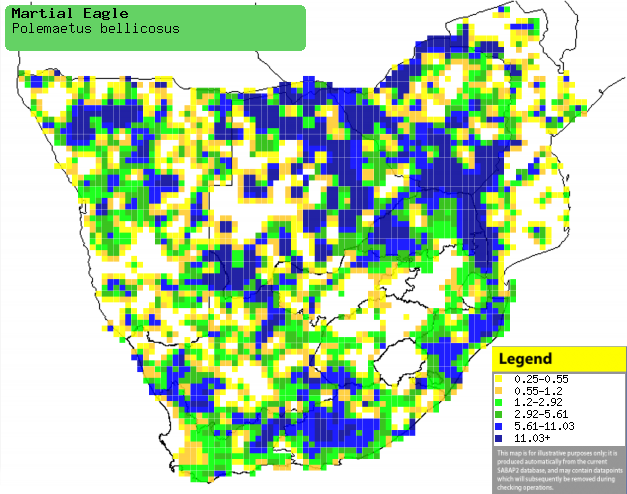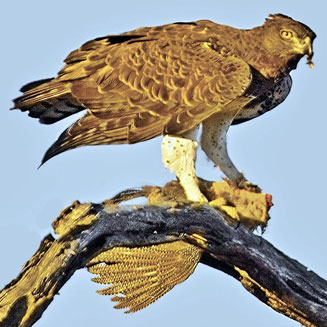|
Polemaetus bellicosus (Martial
eagle)
BreŽkoparend [Afrikaans]; Ukhozi (generic term for eagle)
[Xhosa]; isiHuhwa (also applied to African crowned eagle), uKhozi [Zulu];
Ngongo gepampa [Kwangali]; Gondo (generic name for eagle) [Shona];
Lusotilolukhulu [Swazi]; Rikhozi (generic term for some raptors) [Tsonga];
Ntsu, Ntswi (generic terms for eagles) [Tswana]; Vechtarend [Dutch]; Aigle
martial [French]; Kampfadler [German]; Ńguia-marcial [Portuguese]
Life
> Eukaryotes >
Opisthokonta
> Metazoa (animals) >
Bilateria >
Deuterostomia > Chordata >
Craniata > Vertebrata (vertebrates) > Gnathostomata (jawed
vertebrates) > Teleostomi (teleost fish) > Osteichthyes (bony fish) > Class:
Sarcopterygii (lobe-finned
fish) > Stegocephalia (terrestrial
vertebrates) > Tetrapoda
(four-legged vertebrates) > Reptiliomorpha > Amniota >
Reptilia (reptiles) >
Romeriida > Diapsida > Archosauromorpha > Archosauria >
Dinosauria
(dinosaurs) > Saurischia > Theropoda (bipedal predatory dinosaurs) >
Coelurosauria > Maniraptora > Aves
(birds) > Order: Falconiformes
> Family: Accipitridae
Distribution and habitat
Occupies much of sub-Saharan Africa, excluding the lowland
of West Africa and the DRC. In southern Africa, it is widespread but uncommon, generally preferring
flat, open woodland, such as savanna, forest edges and drainage woodland in
shrubland. It may move into open farmland with stands of trees.
|
 |
|
Distribution of Martial eagle in southern Africa,
based on statistical smoothing of the records from first SA Bird Atlas
Project (©
Animal Demography unit, University of
Cape Town; smoothing by Birgit Erni and Francesca Little). Colours range
from dark blue (most common) through to yellow (least common).
See here for the latest distribution
from the SABAP2. |
Movements and migrations
Mainly resident, although
immature birds may wander great distances.
Food
It eats a variety of animals, especially birds, mammals and
reptiles; the relative proportion of these animals in it's diet varies
greatly in different areas. It does most of its hunting aerially, soaring high
in the air so that it can spot prey up to 6 km away. Once it finds something, it
descends in a long swoop, dropping to the ground with wings and tail spread (as
in the photo above) and striking the prey. Small animals are usually killed
by the impact, but larger prey may have to be strangled to finish them off. The following food items have been recorded
in its diet:
 |
|
|
Martial eagle with dead guineafowl, Kurger
National Park, South Africa. [photo Arno Meintjes
©]s |
|
Breeding
- Monogamous, territorial solitary nester, with a pair bond that often lasts
several breeding seasons.
- The female builds the nest (see image below) over a period of 2-3 weeks.
It consists of a large platform of sticks, with a central cup lined with leaves,
which is
usually about 1.5-2.0 metres wide and 0.5 metres deep, but if used many
times it can be even deeper. It is typically placed in a large, forked
branch below
the canopy of a large tree, especially Knob thorn (Acacia nigrescens)
and Camel thorn (Acacia erioloba); it also nests in high-tension
pylon.
- Egg-laying season is from February-August, peaking from April-June.
- It almost invariably lays a single egg, which is mainly incubated by the
female for about 48-53 days.
- The chick is brooded almost constantly by the female for 2-3
weeks, after which she starts to assist the male with hunting to
provide for their young. The chick typically leaves the nest at about 90-109 days
old, although male chicks may leave earlier. The fledgling
continues to roost in the nest for another 3-8 months, still provided with
food from the female; the fledgling leaves it's parents' territory at the start of the
following breeding season.
Threats
Not threatened globally, but Vulnerable in South
Africa and Endangered in Namibia, largely due to persecution on farmlands.
References
-
Hockey PAR, Dean WRJ and Ryan PG 2005. Roberts
- Birds of southern Africa, VIIth ed. The Trustees of the John Voelcker
Bird Book Fund, Cape Town.
|
